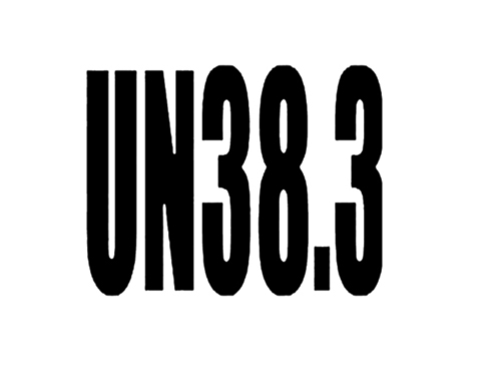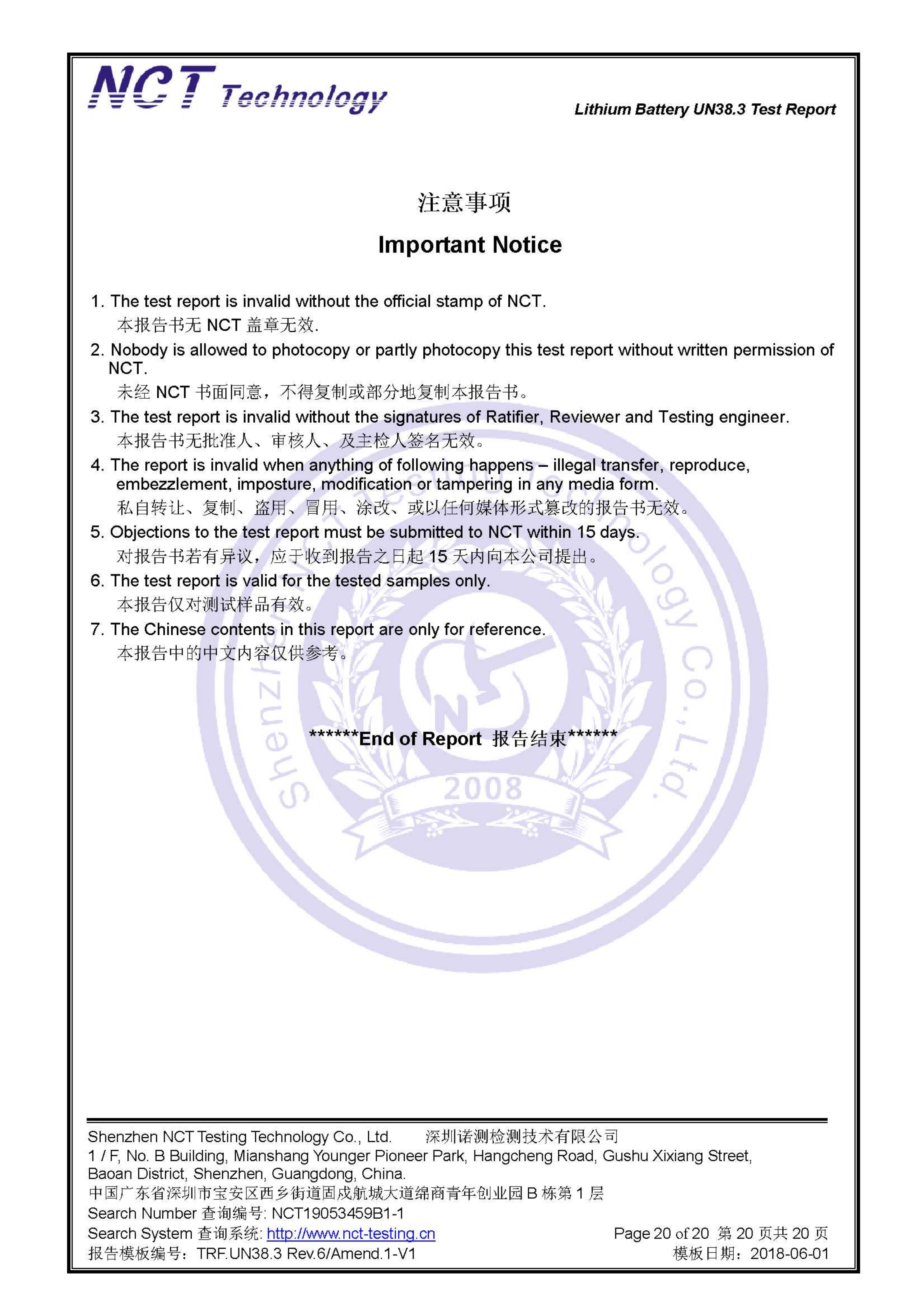UN38.3 Certification of Li Polymer Battery

What’s the UN38.3 Certification?
UN38.3 refers to Section 38.3 of Part 3 of the “United Nations Manual of Tests and Standards for the Transport of Dangerous Goods” specially developed by the United Nations for the transportation of dangerous goods, which requires that lithium batteries must be subjected to highly simulated, high and low-temperature cycles, Vibration test, shock test, 55 ℃ external short circuit, impact test, overcharge test, forced discharge test can ensure the safety of lithium battery transportation. If the lithium battery and the device are not installed together, and more than 24 battery cells or 12 batteries are contained in each package, the 1.2m free drop test must also pass. That is to say before the lithium battery is transported, it must pass the high simulation, high and low-temperature cycling, vibration test, impact test, 55 ℃ external short circuits, impact test, overcharge test, and forced discharge test to ensure the safety of lithium battery transportation. If the lithium battery and the device are not installed together, and more than 24 battery cells or 12 batteries are contained in each package, a 1.2-meter free drop test must also be passed. Our company LiPol Battery Co. can help customers to apply the UN38.3 test report. Each test takes one month after then you will get an official UN38.3 test report published by the third-party testing house (BCTC).
Test Product Range
T.1 Various lead-acid batteries (such as lead-acid batteries for automobile starting, fixed lead-acid batteries, small valve-regulated sealed lead-acid batteries, etc.)
T.2 Various power secondary batteries (such as batteries for power vehicles, batteries for electric road vehicles, batteries for electric tools, batteries for hybrid vehicles, etc.)
T.3 Various mobile phone batteries (such as lithium-ion batteries, lithium polymer batteries, nickel-metal hydride batteries, etc.)
T.4 Various small secondary batteries (such as laptop batteries, digital camera batteries, camera batteries, various cylindrical batteries, wireless communication batteries, portable DVD batteries, CD and MP3 player batteries, etc.)
T.5 Various primary batteries (such as alkaline zinc manganese batteries, lithium manganese batteries, etc.)..
Li Polymer Battery UN38.3 Test Items
T.1 Height simulation test
Under the conditions of pressure ≤11.6kPa and temperature 20 ± 5 ℃, it can be stored for more than 6 hours without leakage, exhaust, disintegration, cracking, and burning.
T.2 Temperature test
High and low-temperature impact test under the conditions of 72 ± 2 ℃ and -40 ± 2 ℃, storage time at limit temperature ≥6h, high and low-temperature conversion time ≤30min, impact 10 times, room temperature (20 ± 5 ℃) storage for 24h.
T.3 Oscillation test
Complete a reciprocating logarithmic frequency sweep sinusoidal vibration from 7Hz to 200Hz in 15min, and complete 12 vibrations in three dimensions in 3h; The logarithmic frequency sweep is: maintain a maximum acceleration of 1gn from 7Hz until the frequency reaches 18Hz. Then keep the amplitude at 0.8mm (total offset of 1.6mm) and increase the frequency until the maximum acceleration reaches 8gn (frequency is about 50Hz). Keep the maximum acceleration at 8gn until the frequency increases to 200 Hz.
T.4 Collision test
Test li polymer battery and lithium-ion battery shall be secured to the testing machine employing a rigid mount which will support all mounting surfaces of each test battery. Each battery cell shall be subjected to a half-sine shock of peak acceleration of 150gn and pulse duration of 6milliseconds. Alternatively, large cells may be subjected to a half-sine shock of peak acceleration of 50gn and pulse duration of 11milliseconds. The pulse duration shall be six milliseconds for the small battery and 11milliseconds for the large battery.
Cells and batteries meet this requirement if there is no mass loss, no leakage, no venting, no disassembly, no rupture, and no fire and if the open-circuit voltage of each test cell or battery after testing is not less than 90%.
T.5 External Short-Circuit
The li polymer battery or the lithium-ion battery cell to be tested shall be temperature stabilized so that its external case temperature reached 57±4℃ and then the cell or battery shall be subjected to a short circuit condition with a total external resistance of fewer than 0.1 ohms at 57±4℃. This short circuit condition is continued for at least one hour after the cell or battery external case temperature has returned to 57±4℃.
Cells and batteries meet this requirement if their external temperature does not exceed 170℃ and there is no disassembly, no rupture, and no fire during the test and within six hours after the test.
T.6 Compression test
Test Procedure- Crush (applicable to prismatic, punch, coin/button cells and cylindrical cells not more than 18mm in diameter).
A prismatic or punch cell shall be crushed by applying the force to the widest side.
A button/coin cell shall be crushed by applying the force on its flat surfaces. For cylindrical cells, the crushing force shall be applied perpendicular to the longitudinal axis.
Each test cell or component cell is to be subjected to one curse only. The test sample shall be observed for a further 6 h. The test shall be conducted using test cells or component cells that have not previously been subjected to other tests.
Li Polymer Battery cells and component cells meet this requirement if their external temperature does not exceed 170℃ and there is no disassembly, no rupture, and no fire during the test and within six hours after the test.
T.7 Overcharge test
The charge current shall be twice the manufacturer’s recommended maximum continuous charge current. Tests are to be conducted at ambient temperature. The duration of the test shall be 24 hours. The minimum voltage of the test shall be as follows: When the manufacturer’s recommended charge voltage is not more than 18v, the minimum voltage of the test shall be the lesser of two times the maximum charge voltage go the battery or 22v.
There is no disassembly and no fire during the test and within seven days after the test.
T.8 Forced discharge test
Each lithium-ion cell shall be forced discharge at ambient temperature by connecting it in series with a 12v D.C. power supply at an initial current equal to the maximum discharge current specified by the manufacturer. The specified discharge current is to be obtained by connecting a resistive load of the appropriate size and rating in series with the test cell. Each cell shall be forced discharged for a time interval (in hours) equal to its related capacity divided by the initial test current) in ampere).
There is no disassembly and no fire during the test and within seven days after the test.
Packaging Requirements
1. Unless installed in equipment (such as mobile phones, cameras, walkie-talkies, laptops, etc.), batteries and primary batteries must be individually packaged to prevent short circuits and stored in the sturdy outer packaging.
2. Unless installed in the equipment, if each package contains more than 24 primary batteries or 12 batteries, it must also meet the following requirements:
1) Each package must be marked with a description of the special measures to be taken when the lithium battery and the package are damaged.
2) Each shipment must have random documents to explain the special measures to be taken when the lithium battery is contained in the package and the package is damaged.
3) Each package must be able to withstand a drop test of 1.2m in any orientation, without damaging the battery or meta-battery in the package, and without changing the position of the battery and the battery and the battery (or the primary battery and the primary battery) Contact, no battery leaked from the package.
4) If the battery is shipped separately, the gross weight of each package must not exceed 10kg.









